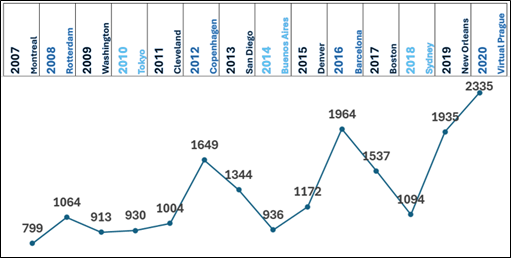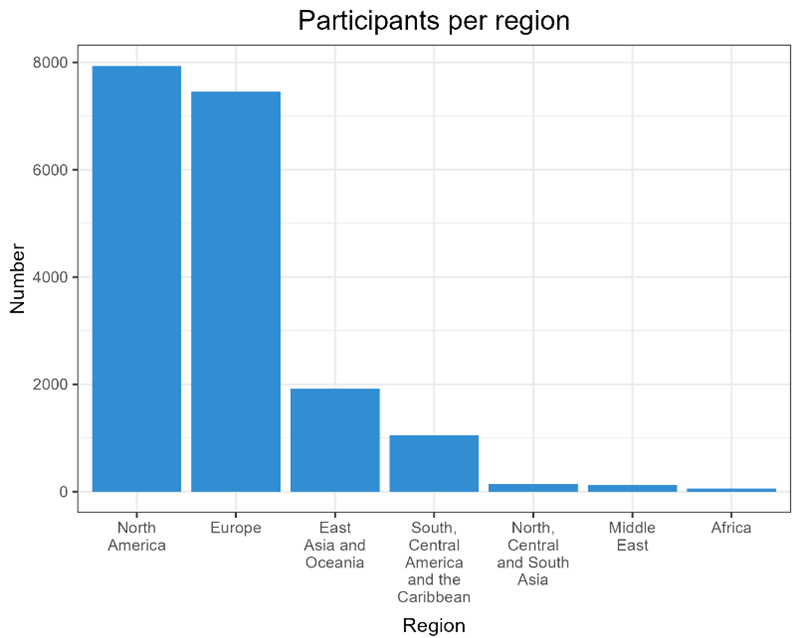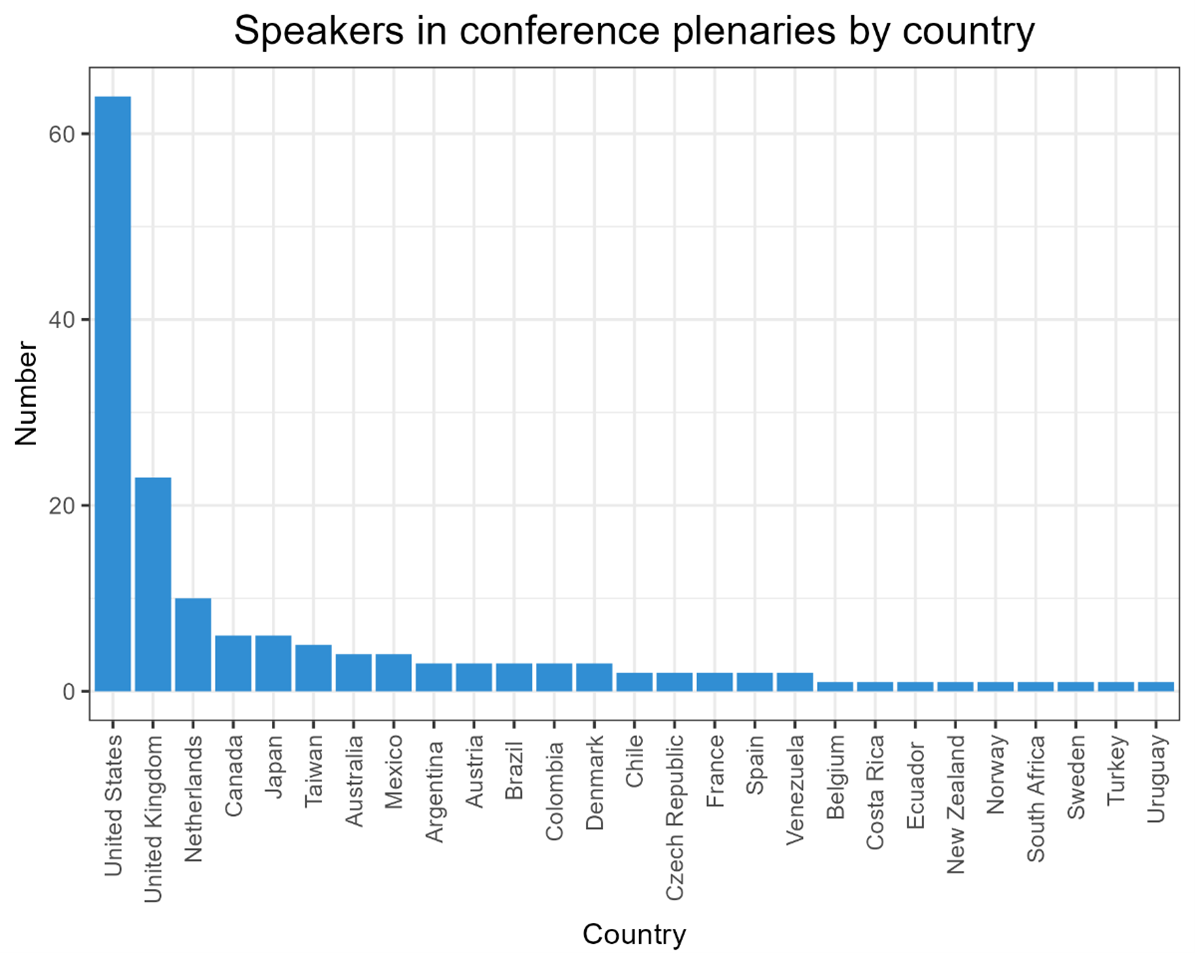Are 4S conferences becoming more transnational?
Noela Invernizzi and Sofía Foladori-Invernizzi07/29/2024 | Reflections
As the Society for Social Studies of Science (4S) approaches its 50th anniversary, the participants in its annual meetings have become more geographically diverse. But it wasn’t always like this. In a presidential message in 1976, Robert Merton wrote: “The 4S has tried to avoid the parochialism of nationality from its inception. Its membership is international although, owing to the occasion of its origin, the largest contingent of members is for the time being from the United States. The Council is at work to extend the international character of the Society”.
In this piece, we explore how transnational 4S meetings have become. Conferences are relevant spaces for shaping scientific fields, where scholars define research agendas, propose theories and methods and build collaboration networks. They are strategic vantage points to gauge the transnationalization of the STS field.
The globalization of the academic work prompted an increased flux of scholars in international conferences in all fields. Yet, we examine transnationalization from other perspective, as a response to our own field’s critique of its Euro-American-centrism (Anderson 2002; Harding 2002, 2011; Law and Lin 2017). Due to data constraints, our analysis focuses on 4S Conferences from 2007 to 2020, examining transnationalization indicators such as venues, attendance and nationality of plenary speakers.
Steps towards transnationalization
One mechanism for transnationalization has been moving the conference venue. After four meetings in the United States, the conference moved to Canada in 1980 and Belgium in 1984, initiating a tradition of joint meetings with the European Association for Studies of Science and Technology (EASST) every four years. In 2010, there was a further move to Japan, then Argentina (2014), Australia (2018) and Mexico (2022). These meetings were organized in collaboration with national/regional STS associations, including the Latin American Association for Social Studies of Science and Technology and the Japanese Society for Science and Technology Studies.
Highlighting this transnational move, Tokyo’s plenary, titled “STS in Global Contexts - What does holding 4S annual meeting in Asia mean for STS research worldwide?”, fostered discussions on universalities and cultural differences in STS concepts, the adaptability of Western-centered ideas, and how perspectives stand between different cultures, bringing to the fore critical epistemic issues in a post-colonial tone.
The theme of Sydney 2018, TRANSnational STS, encapsulated the Society's agenda, encouraging
“… presentations, panels, and other events that deepen and extend the transnational character of the Society itself, while engaging issues invoked by both the TRANS prefix (across, beyond, to change thoroughly), and by the problematic and evolving status of ‘nations’ in processes of global ordering. Leveraging the global scope of Science and Technology Studies (STS), our aim is to intensify connection between conference participants … based in different regions, stimulating conversation about ways 4S and other scholarly societies can provide critical infrastructure for next-generation, transnationally collaborative, intellectual and political engagements.”
Figure 1 shows the tripling of conference attendance over the period, with peaks observed at the joint 4S-EASST meetings. Diverse locations alter the composition of participants. As expected, the local and regional STS scholars’ participation in the new venues increases significantly, evidencing the growing STS community worldwide. For example, while Argentina never attained ten participants in a 4S conference elsewhere, one hundred made it to Buenos Aires. The same occurred in Tokyo, with 256 Japanese participants, about six times the maximum attendance in conferences elsewhere. The number of Australians in Sydney multiplied by 10 their regular participation. Locations as Tokyo and Sydney facilitated regional participation of Taiwanese, Koreans, Chinese, Indians, New Zealanders and Singaporeans.
Transnationalization is also evident in the diversity of participant countries, reaching peaks in Barcelona (2016) and Virtual Prague (2020), with 55 and 54 respectively. Scholars from 86 counties attended the 4S conference from 2007 to 2020. Of these, 44 countries are newcomers with less than ten participants each, concentrated in recent conferences.

Figure 1. 4S Conferences venues and attendance (2007-2020). Meetings in United States and Canada are in black; joint meetings with EASST are in dark blue, and meetings held outside North America and Europe are in light blue.
Figure 2 displays attendance by region, with North America and Europe leading, followed by East Asia and Oceania, and then South and Central America and the Caribbean. The Middle East, North, Central and South Asia, as well as Africa, have had minimal representation. Participation within regions varies significantly; for example, several East and South European countries show lower participation rates.

Figure 2- Participants by region in 4S Conferences during the period 2007-2020
We analyzed the conferences' plenary speakers, as they play a crucial role in shaping themes and theoretical perspectives. There is a notable dominance of scholars from Euro-America, especially from the United States, United Kingdom, and the Netherlands. Up until the Tokyo meeting in 2010, all speakers were from these three countries, except for one Canadian.
In Tokyo and Cleveland (2011) there were Japanese scholars at the plenary. In Buenos Aires, the multilingual plenary “What is STS for? What are STS scholars for? Making and Doing in STS" assembled 26 scholars from Latin America, Europe, United States, Japan and Taiwan, portraying (in 5-minutes presentations) the rich diversity of the field. The transnationalization of the plenaries advanced in the following conferences, featuring speakers from regions beyond North America and Europe at Denver (2015), Boston (2017), Sydney (2018), New Orleans (2019), and Prague (2020). Figure 3 shows the plenary speakers by nationality.

Figure 3- Plenary speakers by nationality in 4S Conferences (2007-2020)
The Society for Social Studies of Science always conceived itself as an international society but remained mostly Euro-American for a long time. The annual conferences have promoted transnationalization by engaging national and regional STS communities in new venues. While East Asian and Latin American scholars’ participation has increased significantly since Tokyo 2010, representation from other regions remains limited. Tokyo also marked a turning point in showcasing diverse STS perspectives in plenaries, which was broadened in Buenos Aires, while Sydney clearly set transnationalization as a 4S agenda.
Despite these strides, there is still transnationalization work to do, and much to learn about STS across different regions of the world.
Noela Invernizzi holds a PhD in Science and Technology Policy and is a Full professor at the Education and Public Policy programs at the Federal University of Parana.
Sofia Foladori has a master’s in Science, Technology and Innovation, and another in Environmental Science. She is a Research Associate at the Bern University of Applied Sciences.
Published: 07/29/2024
